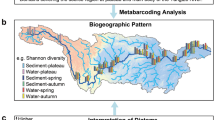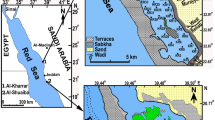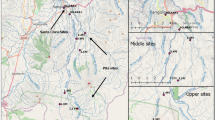Abstract
The sampling skills of three common European fish species (Barbus barbus, Chondrostoma nasus and Squalius cephalus) were tested to assess their potential as biomonitors of past changes in river water quality through the analysis of diatoms in fish guts. The study was performed on three rivers with different chemical and physical conditions. Comparison of similarity indices revealed low diatom assemblage resemblance between epilithic samples and samples collected from fish guts at the same locality. In contrast, a mixed-effect linear model identified significant differences between locations through comparison of diatom-based water quality indices. Among fish species, diatom indices calculated from gut samples of B. barbus and C. nasus were in most cases not significantly different from those from epilithic samples while those from S. cephalus were often significantly different. The results of the study demonstrate that diatom analysis of fish guts provides a clear distinction between eutrophic and hypereutrophic rivers. Finer nutrient variations within hypereutrophic conditions were also found to be significant for some diatom indices. In this context, choice of appropriate diatom water quality index proved to be crucial in maximizing the sensitivity of the method.




Similar content being viewed by others
References
Balestrieri, A., C. Prigioni, L. Remonti, S. Sgrosso & G. Priore, 2006. Feeding ecology of Leuciscus cephalus and Rutilus rubilio in southern Italy. Italian Journal of Zoology 73: 129–135.
Battarbee, R. W., 1986. Diatom analysis. In Berglund, B. E. (ed.), Handbook of Holocene Paleoecology and Paleohydrology. Wiley, Chichester: 527–570.
Battarbee, R. W., D. F. Charles, S. S. Dixit & I. Renberg, 1999. Diatoms as indicators of surface water acidity. In Stoermer, F. & J. P. Smol (eds), The Diatoms: Applications for the Environmental and Earth Sciences. Cambridge University Press, Cambridge: 85–127.
Bray, J. R. & J. T. Curtis, 1957. An ordination of upland forest communities of southern Wisconsin. Ecological Monographs 27: 325–349.
Bennion, H., S. Juggins & N. J. Anderson, 1996. Predicting epilimnetic phosphorus concentrations using an improved diatom-based transfer function and its application to lake eutrophication management. Environmental Science and Technology 30: 2004–2007.
Birks, H. J. B., J. M. Line, S. Juggins, A. C. Stevenson & C. J. F. ter Braak, 1990. Diatoms and pH reconstruction. Philosophical Transactions of the Royal Society of London B 327: 263–278.
CEMAGREF (Centre National du Machinisme Agricole du Génie Rural, des Eaux et des Forets), 1982. Etude des méthodes biologiques d’appréciation quantitative de la qualité des eaux. Rapport Q.E. Lyon. Division Qualité des Eaux - Pêche et Pisciculture, Lyon.
Copp, G. H., 2010. Patterns of diel activity and species richness in young and small fishes of European streams: a review of 20 years of point abundance sampling by electrofishing. Fish and Fisheries 11: 439–460.
Dell’Uomo, A., 2004. L’indice Diatomico di Eutrofizzazione/Polluzione (EPI-D) nel Monitoraggio Delle Acque Correnti. Linee guida. A.P.A.T., A.R.P.A.T.
Descy, J. P., 1979. A new approach to water quality estimation using diatoms. Nova Hedwigia 64: 305–323.
Descy, J. P. & M. Coste, 1991. A test of methods for assessing water quality based on diatoms. Verhandlungen des Internationalen Verein Limnologie 24: 2112–2116.
EN 1484, 1998. Water Analysis – Guidelines for the Determination of Total Organic Carbon (toc) and Dissolved Organic Carbon (doc).
EN 26777, 1999. Water Quality – Determination of Nitrite – Molecular Absorption Spectrometric Method.
EN 12260, 2004. Water Quality – Determination of Nitrogen – Determination Of Bound Nitrogen (tnb), following Oxidation to Nitrogen Oxides.
European Union, 2000. Directive 2000/60/EC of the European Parliament and of the Council of 23 October 20000 establishing a framework for community action in the field of water policy. Official Journal European Communication L327: 1–72.
Faria, J. C., 2009. Resources of Tinn-R GUI/Editor for R Environment. UESC, Ilheus, Brazil.
Fott, B., 1954. Pleurax, synthetická pryskyřice pro preparaci rozsivek [Pleurax, a synthetic resin for diatom preparation]. Preslia 26: 163–194.
Hall, R. I. & J. P. Smol, 1999. Diatoms as indicators of lake eutrophication. In Stoermer, F. & J. P. Smol (eds), The Diatoms: Applications for the Environmental and Earth Sciences. Cambridge University Press, Cambridge: 128–168.
Hanel, L. & S. Lusk, 2005. Ryby a mihule České Republiky: Rozšíření a ochrana [Fishes and lampreys of the Czech Republic: distribution and conservation]. ZO ČSOP Vlašim, Vlašim.
Hill, M. O., 1973. Diversity and evenness: a unifying notation and its consequences. Ecology 54: 427–432.
Holm, S., 1979. A simple sequentially rejective multiple test procedure. Scandinavian Journal of Statistics 6: 65–70.
Horn, H. H., 1983. Optimal diets in complex environments: feeding strategies of two herbivorous fishes from a temporate rocky interdidal zone. Oecologia 58: 345–350.
Hothorn, T., F. Bretz & P. Westfall, 2008. Simultaneous inference in general parametric models. Biometrical Journal 50: 346–363.
Houk, V., 2003. Atlas of freshwater centric diatoms with a brief key and descriptions—Part 1: Melosiraceae, Orthoseiraceae, Paraliaceae and Aulacoseiraceae. Czech Phycology Supplement 1: 1–27.
Hurlimann, J. & P. Niederhauser, 2006. Methoden zur Untersuchung und Beurteilung der Fliessgewasser: Kieselalgen Stufe F (flachendeckend) Bundesamt fur Umwelt. BAFU, Bern.
ISO 7150-1, 1984. Water quality – Determination of ammonium – Part 1: Manual spectrometric method.
ISO 15705, 2002. Water quality – Determination of the chemical oxygen demand index (ST-COD) – Small-scale sealed-tube method.
ISO 6878, 2004. Water quality – Determination of phosphorus – Ammonium molybdate spectrometric method.
ISO 10304-1, 2007. Water quality – Determination of dissolved anions by liquid chromatography of ions – Part 1: Determination of bromide, chloride, fluoride, nitrate, nitrite, phosphate and sulfate.
Kamler, J. F. & K. L. Pope, 2001. Nonlethal methods of examining fish stomach contents. Reviews in Fisheries Science 9: 1–11.
Kelly, M. G., 2001. Use of similarity measures for quality control of benthic diatom samples. Water research 35: 2784–2788.
Kelly, M. G. & B. A. Whitton, 1995. The Trophic Diatom Index: a new index for monitoring eutrophication in rivers. Journal of Applied Phycology 7: 433–444.
Kelly, M. G., A. Cazaubon, E. Coring, A. Dell’Uomo, L. Ector, B. Goldsmith, H. Guasch, J. Hürlimann, A. Jarlman, B. Kawecka, J. Kwandrans, R. Laugaste, E.-A. Lindstrøm, M. Leitao, P. Marvan, J. Padisák, E. Pipp, J. Prygiel, E. Rott, S. Sabater, H. van Dam & J. Vizinet, 1998. Recommendations for the routine sampling of diatoms for water quality assessments in Europe. Journal of Applied Phycology 10: 215–224.
Krammer, K., 1997a. Die Cymbelloiden Diatomeen. Eine Monagraphie der weltweit bekannten Taxa. Teil 1. Allgemeines und Encyonema part. Bibliotheca Diatomologica Band 36. J. Cramer, Stuttgart.
Krammer, K., 1997b. Die Cymbelloiden Diatomeen. Eine Monographie der weltweit bekannten Taxa. Teil 2. Encyonema part., Encyonopsis und Cymbellopsis. Bibliotheca Diatomologica Band 37. J. Cramer, Stuttgart: 1–469.
Krammer, K., 2000. Diatoms of Europe. Diatoms of European Inland Waters and Comparable Habitats, Vol. 1. The Genus Pinnularia. A.R.G. Gantner Verlag K.G., Ruggel.
Krammer, K., 2002. Diatoms of Europe. Diatoms of the European Inland Waters and Comparable Habitats. Vol. 3. Cymbella. A.R.G. Gantner Verlag K.G., Ruggell.
Krammer, K., 2003. Diatoms of Europe. Diatoms of the European Inland Waters and Comparable Habitats, Vol. 4. Cymbopleura, Delicata, Navicymbulla, Gomphocymbellopsis, Afrocymbella. A.R.G. Gantner Verlag K.G., Ruggell.
Krammer, K. & H. Lange-Bertalot, 1986. Bacillariophyceae (Naviculaceae). In Ettl, H., J. Gerloff, H. Heinig & D. Mollenhauer (eds), Süsswasserflora von Mitteleuropa, (2(1)). Gustav Fisher Verlag, Stuttgart.
Krammer, K. & H. Lange-Bertalot, 1988. Bacillariophyceae (Bacillariaceae, Epithemiaceae, Surirellaceae). In Ettl, H., J. Gerloff, H. Heinig & D. Mollenhauer (eds), Süsswasserflora von Mitteleuropa, (2 (2)). Gustav Fisher Verlag, Stuttgart.
Krammer, K. & H. Lange-Bertalot, 1991a. Bacillariophyceae (Centrales, Fragilariaceae, Eunotiaceae). In Ettl, H., J. Gerloff, H. Heinig & D. Mollenhauer (eds), Süsswasserflora von Mitteleuropa, (2 (3)). Gustav Fisher Verlag, Stuttgart.
Krammer, K. & H. Lange-Bertalot, 1991b. Bacillariophyceae (Achnanteaceae, Kritische Ergänzungen zu Navicula (Lineolateae) und Gomphonema Gesamtliteraturverzeichnis). In Ettl, H., J. Gerloff, H. Heinig & D. Mollenhauer (eds), Süsswasserflora von Mitteleuropa, (2(4)). Gustav Fisher Verlag, Stuttgart.
Lavoie, I. & S. Campeau, 2010. Fishing for diatoms: fish gut analysis reveals water quality changes over a 75-year period. Journal of Paleolimnology 43: 121–130.
Leclerq, L. & B. Maquet, 1987. Deux nouveaux indices chimique et diatomique de qualité d’eau courante. Application au Samson et a ses affluents (Bassin de la Meuse Belge). Comparaison avec d’autres indices chimiques biocénotiques et diatomiques, Doc.Trav. Royal Belgian Institute of Natural Sciences, Brussels.
Lenoir, A. & M. Coste, 1996. Development of a practical diatom index of overall water quality applicable to the French National Water Board Network. In Whitton B. A. & E. Rott (eds), Use of Algae for Monitoring Rivers II. Inst. Bot, Univ. Innsbruck: 29–43.
Lepš, J. & P. Šmilauer, 2003. Multivariate Analysis of Ecological Data Using CANOCO. Cambridge University Press, Cambridge.
Lobo, E. A., V. L. M. Callegaro & E. P. Bender, 2002. Utilizacao de Algas Diatomaceas Epiliticas como Indicadores da Qualidade da Agua em Rios e Arroios da Regiao Hidrografica do Guaiba, RS, Brasil. EDUNISC, Santa Cruz do Sul.
Losos, B., M. Peňáz & J. Kubičnová, 1980. Food and growth of fishes of the Jihlava River. Acta Scientarum Naturalium Academiae Scientiarum Bohemicae Brno 14: 1–46.
Marvan, P., L. Opatřilová, J. Heteša, M. Maciak & P. Horký, 2011. Metodika hodnocení ekologického stavu útvarů povrchových vod tekoucích (kategorie řeka) pomocí biologické složky fytobentos. [Methodics of assessment of ecological status of surface flowing waters (category River) using phytobenthos]. Final Report, Prague.
Northern Ireland Environment Agency, 2009. River Basin Management Plans: Rationale for Water Framework Directive Freshwater Classification.
Oksanen, J., F. G. Blanchet, R. Kindt, P. Legendre, R. B. O’Hara, G. L. Simpson, P. Solymos, M. H. Stevens & H. Wagner, 2010. vegan: Community Ecology Package. R Package Version 1.17-2. http://CRAN.R-project.org/package=vegan.
Pinheiro, J., D. Bates, S. DebRoy & D. Sarkar, 2005. nlme: Linear and Nonlinear Mixed Effects Models – R Package. R Foundation for Statistical Computing, Vienna.
Piria, M., T. Treer, I. Aničič, R. Safner & T. Odak, 2005. The natural diet of five cyprinid fish species. Aquaculture Conspectus Scientificus 70: 21–28.
Prygiel, J., L. Leveque & R. Iserentant, 1996. Un nouvel indice diatomique pratique pour l’évaluation de la qqualité des eaux en réseau de surveillance. Revue des sciences de l’eau 9: 97–113.
R Development Core Team, 2010. R: A Language and Environment for Statistical Computing. R Foundation for Statistical Computing, Vienna, Austria. ISBN 3-900051-07-0. http://www.R-project.org.
Reckendorfer, W., H. Keckeis, V. Tiitu, G. Winkler, H. Zornig & F. Schiemer, 2001. Diet shifts in 0+ nase, Chondrostoma nasus: Size-specific differences and the effect of food availability. Archiv für Hydrobiologie Supplementband 135: 425–440.
Rosati, T. C., J. R. Johansen & M. M. Coburn, 2003. Cyprinid fishes as samplers of benthic diatom communities in freshwater streams of varying water quality. Canadian Journal of Fisheries and Aquatic Sciences 60: 117–125.
Rott, E., G. Hofmann, K. Pall, P. Pfister & E. Pipp, 1997. Indikationslisten für Aufwuchsalgen Teil 1: Saprobielle indikation. Bundesministerium für Land- und Forstwirtschaft, Wien.
Rott, E., E. Pipp, P. Pfister, H. V. Dam, K. Orther, N. Binder & K. Pall, 1999. Indikationslisten für Aufwuchsalgen in Österreichischen Fliessgewassern. Teil 2: Trophieindikation. Bundesministerium für Land- und Forstwirtschaft. Wien.
Rumeau, A. & M. Coste, 1988. Initiation la ssistematique des diatomées d’eau douce. pour l’utilisation pratique d’un indice diatomique générique. Bulletin Francais de la Peche et de la Pisciculture 309: 1–69.
Sellman, S. M, J. R. Johansen & M. M. Coburn, 2002. Using fish to sample diatom composition in streams: are intestinal flora representative of natural substrates? In Proceedings of 16th International Diatom Symposium, Athens & Aegean Islands. University of Athens, Greece.
Shirey, P. D., D. E. Cowley & R. Sallenave, 2008. Diatoms from gut contents of museum specimens of an endangered minnow suggest long-term ecological changes in the Rio Grande (USA). Journal of Paleolimnology 40: 263–272.
Sládeček, V., 1986. Diatoms as indicators of organic pollution. Acta Hydrochimica et Hydrobiologica 14: 555–566.
Smol, J. P. & B. F. Cumming, 2000. Tracking long-term changes in climate using algal indicators in lake sediments. Journal of Phycology 36: 986–1011.
Sray, J., 1998. Reconstructing historical diatom community composition of rivers using the Cyprinid fish Hybognathus nuchalis. M.Sc. Thesis, John Carroll University, University Heights, Ohio, USA.
Steinberg, C. & S. Schiefele, 1988. Biological indication of trophy and pollution of running waters. Zeitschrift für Wasser und Abwasserforschung 21: 227–234.
Ter Braak, C. J. F. & P. Šmilauer, 2012. Canoco Reference Manual and User’s Guide: Software for Ordination, version 5.0. Microcomputer Power, Ithaca, USA.
Van Dam, H., A. Martens & J. Sinkeldam, 1994. A coded checklist and ecological indicator values of freshwater diatoms from the Netherlands. Netherlands Journal of Aquatic Ecology 28: 117–133.
Vollenweider, R. A. & Kerekes, J., 1982. Eutrophication of Waters. Monitoring, Assessment and Control. OECD Cooperative Programme on Monitoring of Inland Waters. Environment Directorate, OECD, Paris.
Watanabe, T., K. Asai & A. Houki, 1986. Numerical estimation to organic pollution of flowing water by using the epilithic diatom assemblage – diatom assemblage index (DAIpo). Science of Total Environment 55: 209–218.
YSI incorporated, 1999. YSI Environmental Operations Manual.
Acknowledgements
The authors would like to thank Povodí Vltavy, state enterprise, for providing long-term hydrochemical data, R. Harant and R. Hrdlička for help with fish sampling, P. Šmilauer for consultation of LME models and anonymous reviewers for substantial improvement of the manuscript. The research was funded by the grant from The Ministry of Education of the Czech Republic: FRVŠ 2284/2008 and by the Grant of Grant Agency of Czech Republic: GACR 13-11193S.
Author information
Authors and Affiliations
Corresponding author
Additional information
Handling editor: Jasmine Saros
Rights and permissions
About this article
Cite this article
Bešta, T., Muška, M., Juggins, S. et al. Comparison of diatom community structure from epilithon and fish guts: implications for inferring past changes in water quality. Hydrobiologia 742, 233–248 (2015). https://doi.org/10.1007/s10750-014-1987-1
Received:
Revised:
Accepted:
Published:
Issue Date:
DOI: https://doi.org/10.1007/s10750-014-1987-1




